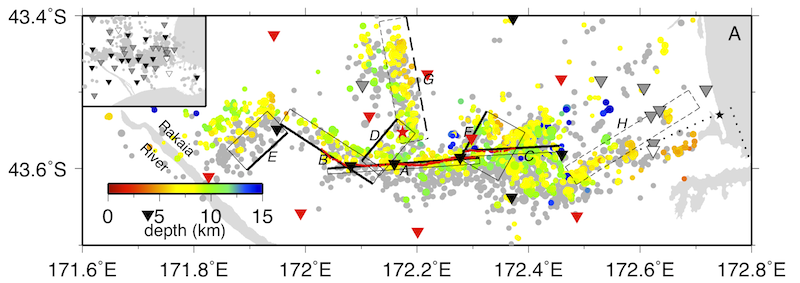2012 IRIS Workshop
Temporal and Spatial Evolution of Hypocentres and Anisotropy from the Darfield Aftershock Sequence: Implications for Fault Geometry and Age
Ellen M. Syracuse: University of Wisconsin-Madison, Rob A. Holt: Victoria University of Wellington, Martha K. Savage: Victoria University of Wellington, Jessica H. Johnson: Victoria University of Well
Relocated (color) and catalog (grey) events, scaled by magnitude. Triangles are stations: temporary (black), permanent (white), strong-motion (grey). Red line is surface rupture, red star is epicenter. Bold black lines are updip extents of fault planes (Beavan et al. 2010), thin solid lines are downdip extents. Dashed lines are fault segments G and H, identified here. Dotted lines are faults under Christchurch. Black star is epicenter of 02/11 Christchurch earthquake. Inset shows stations used.

Full-resolution graphics file in original format: 0044.jpg
The first four months of aftershocks of the Darfield earthquake have been studied using data from temporary and permanent seismic stations to investigate the fault geometry, stress field, and evolution of seismicity and seismic properties. Earthquake relocations illuminate fault segments and show that the majority of aftershocks occurred beyond the areas of highest slip during the Darfield earthquake. Seismic anisotropy shows a mixture of fast directions parallel to the maximum horizontal stress and fault-parallel fast directions. This, combined with the lack of observable growth of seismicity along fault segments, suggests the Greendale Fault broke a pre-existing fault plane.
Acknoweldgements: This work was funded by grants from the NZ EQC, the US NSF (EAR-1102767 and EAR-1141983), and GNS Science. GNS Science Wairakei, University of Auckland and PASSCAL provided instrumentation. We thank M. Reyners, A. Zaino, J. Eccles, K. Jacobs, C. Boese, R. Davy, A. Wech, N. Lord, A. Carrizales, Z. Rawlinson, J. Townend, P. Malin, B. Fry, P. Skorstengaard, R. Hart, and G. Potaka.
For further reading: Ellen M. Syracuse, Rob A. Holt, Martha K. Savage, Jessica H. Johnson, Clifford H. Thurber, Katharina Unglert, Kirsty N. Allan, Sapthalla Karaliyadda, and Mark Henderson (2012), Temporal and spatial evolution of hypocentres and anisotropy from the Darfield aftershock sequence: Implications for fault geometry and age, New Zealand Journal of Geology and Geophysics, in press.
Keywords: darfield_earthquake, aftershocks, anisotropy
